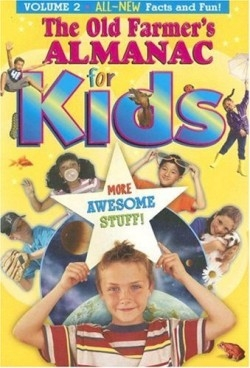It looks like you've stumbled upon a page meant to be read by our code instead of viewed directly. You're probably looking for this page.
The Old Farmer's Almanac for Kids (Volume 2)
Did you know that ancient Egyptians cleaned their teeth with a powdered oxen hooves and burnt eggshells? Or that Ben Cohen and Jerry Greenfield started their empire by taking a three dollar correspondence course on how to make ice cream? Readers of this snazzy second volume of The Old Farmer’s Almanac for Kids will enjoy learning the answers to hundreds of oddball queries as much as adults have enjoyed the Old Farmer’s Almanac for centuries. The almanac, published every year since 1792, is the “oldest continuously published periodical in America,” according to Wikipedia. Colorful illustrations and a cheerfully bustling design make this collection of little-known facts and funny coincidences both a fun read and a rich source for dinner table conversations.
Although the book’s organization may seem random to many young (and older) readers, it conforms to the adult almanacs with entries about the weather, astronomy, gardening, history, sports, and health. The book begins with a page for each month of the year that gives at least one historical or natural fact or proverb about each day. August 11, for example, connects the weather note—Dog Days end—to a proverb: “Don’t keep dogs and bark yourself.”
Floods, it turns out, are not just instances of watery excess. There was the great molasses flood of 1919, when a 14,000 ton tank of molasses exploded, creating a fifteen-foot-high wave that “picked up a boy and carried him several blocks like a surfer.” Twenty one people died in the explosion. There was also the pumpkin flood of October, 1786, when rising flood waters in Pennsylvania pulled ripe pumpkins off their vines and into the rushing current. The pumpkins were like cannonballs, one witness said, and they did a lot of damage when they hit people and houses.
Since both pumpkins and bicycles roll, kids (and adults) who like to flip pages rather than read straight through might next become immersed in the fascinating multi-page spread that documents the history of the bicycle. Cartoon drawings and timelines take readers back to 1817, when the first two-wheeled “gismo” was invented by Karl von Drais. Debunking a myth that Leonardo da Vinci envisioned the first bike, the entry spins along through various inventive triumphs and mishaps, including a bunch of funny names, such as “velocipede” for the 1817 version, the metal-wheeled “boneshakers” of Frenchman Pierre Michaux in 1861, and English “penny farthings,” so named because these they had a big wheel in front (the farthing) and a little wheel (the penny) in the back.
Little known facts about the achievements of women and girls: Annie Cohen Londonderry, a young mother of three, became the first person to bicycle around the world (with a little help from ocean liners) in 1894. Seventeen-year-old Lizzie Arlington became “the first woman to sign a minor league [baseball] contract” in 1898. She was known as “The Girl Who Struck Out Babe Ruth.” In 1930, eleven-year-old Venetia Burner Phair suggested the name Pluto for the now down-graded “dwarf planet.” A sidebar points out that Venetia’s great-uncle “suggested the names Phobos and Deimos, both from Greek mythology, for Mars’s moons.”
If the name Phobos makes readers think of their own phobias, they won’t be wrong. Phobos means “fear” in Greek, and the many things that terrify people aren’t neglected here. Cryophobics are afraid of frost and ice, and fear of rain has two names: ombrophobia and pluviophobia. A fear of vegetables—as picky eaters will be delighted to learn—is lachanophobia, a psychologically valid reason to get out of eating okra or Brussels sprouts.
The book’s layout and design encourage browsing, an enticement for reluctant readers. The encyclopedic detail of each entry is whimsical, more of a “did you know?” that could turn up as a game show question on TV than an effort to create comprehensive knowledge. The busy design of each page, replete with photographs, cartoons, sidebars, and up-to-date language, looks like a computer screen or comic book. This book will make a great addition for home libraries as well as for reference sections. Kids like knowing things just as much as adults do, and this book offers an unusual opportunity to attract kids to reading who are more accustomed to looking at a computer screen than at books.
Reviewed by
Elizabeth Breau
Disclosure: This article is not an endorsement, but a review. The publisher of this book provided free copies of the book to have their book reviewed by a professional reviewer. No fee was paid by the publisher for this review. Foreword Reviews only recommends books that we love. Foreword Magazine, Inc. is disclosing this in accordance with the Federal Trade Commission’s 16 CFR, Part 255.
